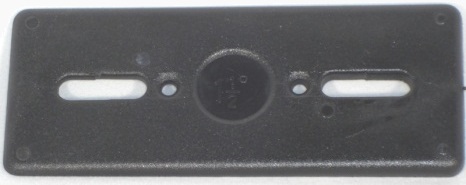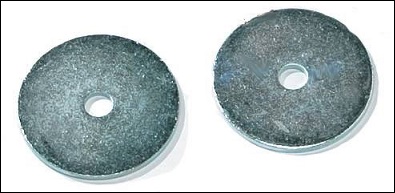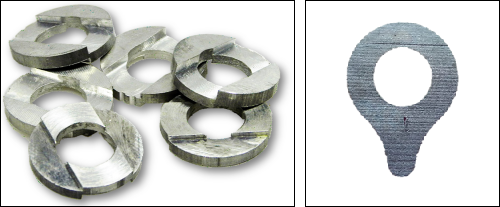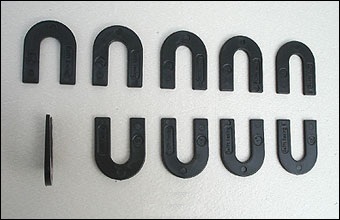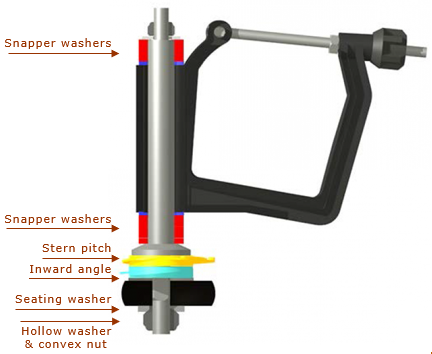|
|
Adjust the pin pitch & angle |
The effect of adjusting the sternward pin pitch and outward pin angle cannot be separated from each other. This can be understood by looking at the extreme values. When the oar is placed parallel to the boat on the catch, the angle of the oar approaches the outward angle. When the oar is perpendicular to the boat, it is equal to the stern pitch (it is assumed that the oarlock and blade pitch both are zero degrees). The two angles influence each other in the intermediate region.
Bow
There are several tools on the market to bend the riggers. This allows the oarlock pin angle be set exactly vertical. This is done by bending the rigger (and not the oarlock pin!). Older riggers can be brittle, causing them to crack rather than bend. Once set up in this way, riggers no longer need to be adjusted during normal use.
| Stern | Outward | |
| Wing rigger | no | no |
| Classic rigger | Yes | Yes |
Rigger wedges
Wedges can be placed between the rigger and the boat for classic riggers. Using wedges with different angles to change the outward angle: a 1.5° wedge will also change the outward angle by 1.5°. The major disadvantage of these wedges is that the oarlock height is also adjusted simultaneously. When a wedge is placed it is recommended - if the oarlocks are equipped with aluminium washers - to use these washers to set all oarlocks to the required height.
| Stern | Outward | |
| Wing rigger | new | new |
| Classic rigger | new | Yes |
Washers
By placing washers between boat and wingrigger, the stern pitch of the oarlock pin can be adjusted. It is difficult to set the stern pitches of both pins independently. Therefore, this is not an elegant method.
| Stern | Outward | |
| Wing rigger | Limited | no |
| Classic rigger | no | no |
Aluminum adjusting washers
Two types of aluminium adjusting washers exist, suitable for adjusting the stern pitch and suitable for adjusting the outward angle. The washers start at 0.5 degrees and go up to 3 degrees in steps of a half degree. When placed both above and below (in the opposite direction of the top washer!), four are needed per oarlock pin (two for the stern pitch and two for the outward angle) and therefore eight per rowing place. An excellent and durable but expensive solution, because these washers are not cheap.
If the oarlock pin can not be adjusted sufficiently sternward, this is because the thickness of the wing rigger leaves insufficient tilting space for the screw thread of the oarlock pin. If a oarlock pin with M12 thread is placed, it can be replaced by a oarlock pin with M10 thread. This creates 2mm extra tilting space. That is why this setting option is called “Limited” in the table.
| Stern | Outward | |
| Wing rigger | Limited | Yes |
| Classic rigger | Limited | Yes |
Plastic adjusting wedges
Not sustainable but cheap. This is therefore an attractive option, but it is important that the adjusting wedges used for the outward angle are marked. Otherwise, when loosening the oarlock not obvious which adjusting wedge belongs to which pitch/angle (forward or outward). It is also important to mount these adjusting wedges both above and below (in the opposite direction) and to clamp them between normal metal washers, so that they are not damaged when tightening the pin nut.
| Stern | Outward | |
| Wing rigger | Limited | Yes |
| Classic rigger | Limited | Yes |
Axior oarlock
Finally, the Axior dol offers a attractive solution. Its expensive purchase price only justifies its use when the angles need significant adjustment. By adjusting the yellow and blue adjustment rings, the oarlock pin can be placed in any desired position. For the (thicker) wingriggers, always take a rigger with M12 hole and an Axior oarlock with M10 thread to have enough adjustment space for the forward angle.
| Stern | Outward | |
| Wing rigger | Limited | Yes |
| Classic rigger | Limited | Yes |
 |
Stern pitch oarlock pin |
 |
Outward angle oarlock pin |
This article was translated automatically and is provided to you for free. You are most welcome to improve it!













